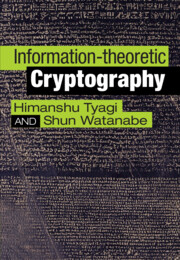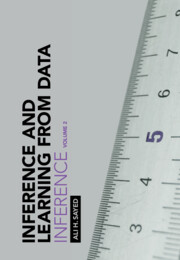Refine listing
Actions for selected content:
9096 results in Communications, Signal Processing and Information Theory
13 - Oblivious Transfer from Correlated Randomness
- from Part II - Internal Adversary: Secure Computation
-
- Book:
- Information-theoretic Cryptography
- Published online:
- 23 March 2023
- Print publication:
- 13 April 2023, pp 262-289
-
- Chapter
- Export citation
Contents
-
- Book:
- Information-theoretic Cryptography
- Published online:
- 23 March 2023
- Print publication:
- 13 April 2023, pp vii-xii
-
- Chapter
- Export citation
References
-
- Book:
- Information-theoretic Cryptography
- Published online:
- 23 March 2023
- Print publication:
- 13 April 2023, pp 473-494
-
- Chapter
- Export citation
Frontmatter
-
- Book:
- Information-theoretic Cryptography
- Published online:
- 23 March 2023
- Print publication:
- 13 April 2023, pp i-iv
-
- Chapter
- Export citation
Index
-
- Book:
- Information-theoretic Cryptography
- Published online:
- 23 March 2023
- Print publication:
- 13 April 2023, pp 496-504
-
- Chapter
- Export citation
3 - Secret Keys and Encryption
- from Part I - External Adversary: Encryption, Authentication, Secret Key
-
- Book:
- Information-theoretic Cryptography
- Published online:
- 23 March 2023
- Print publication:
- 13 April 2023, pp 47-65
-
- Chapter
- Export citation
Part II - Internal Adversary: Secure Computation
-
- Book:
- Information-theoretic Cryptography
- Published online:
- 23 March 2023
- Print publication:
- 13 April 2023, pp 207-208
-
- Chapter
- Export citation
Symbol Index
-
- Book:
- Information-theoretic Cryptography
- Published online:
- 23 March 2023
- Print publication:
- 13 April 2023, pp 495-495
-
- Chapter
- Export citation
Part I - External Adversary: Encryption, Authentication, Secret Key
-
- Book:
- Information-theoretic Cryptography
- Published online:
- 23 March 2023
- Print publication:
- 13 April 2023, pp 13-14
-
- Chapter
- Export citation
Appendix - Solutions to Selected Problems
-
- Book:
- Information-theoretic Cryptography
- Published online:
- 23 March 2023
- Print publication:
- 13 April 2023, pp 462-472
-
- Chapter
- Export citation
5 - Hypothesis Testing
- from Part I - External Adversary: Encryption, Authentication, Secret Key
-
- Book:
- Information-theoretic Cryptography
- Published online:
- 23 March 2023
- Print publication:
- 13 April 2023, pp 87-103
-
- Chapter
- Export citation
10 - Secret Key Agreement
- from Part I - External Adversary: Encryption, Authentication, Secret Key
-
- Book:
- Information-theoretic Cryptography
- Published online:
- 23 March 2023
- Print publication:
- 13 April 2023, pp 177-206
-
- Chapter
- Export citation
14 - Bit Commitment from Correlated Randomness
- from Part II - Internal Adversary: Secure Computation
-
- Book:
- Information-theoretic Cryptography
- Published online:
- 23 March 2023
- Print publication:
- 13 April 2023, pp 290-311
-
- Chapter
- Export citation
Preface
-
- Book:
- Information-theoretic Cryptography
- Published online:
- 23 March 2023
- Print publication:
- 13 April 2023, pp xiii-xiv
-
- Chapter
- Export citation
8 - Authentication
- from Part I - External Adversary: Encryption, Authentication, Secret Key
-
- Book:
- Information-theoretic Cryptography
- Published online:
- 23 March 2023
- Print publication:
- 13 April 2023, pp 139-157
-
- Chapter
- Export citation
15 - Active Adversary and Composable Security
- from Part II - Internal Adversary: Secure Computation
-
- Book:
- Information-theoretic Cryptography
- Published online:
- 23 March 2023
- Print publication:
- 13 April 2023, pp 312-361
-
- Chapter
- Export citation
12 - Two-party Secure Computation for a Passive Adversary
- from Part II - Internal Adversary: Secure Computation
-
- Book:
- Information-theoretic Cryptography
- Published online:
- 23 March 2023
- Print publication:
- 13 April 2023, pp 227-261
-
- Chapter
- Export citation

Information-theoretic Cryptography
-
- Published online:
- 23 March 2023
- Print publication:
- 13 April 2023

Inference and Learning from Data
- Inference
-
- Published online:
- 17 March 2023
- Print publication:
- 22 December 2022
-
- Textbook
- Export citation
9 - Quotient manifolds
-
- Book:
- An Introduction to Optimization on Smooth Manifolds
- Published online:
- 09 March 2023
- Print publication:
- 16 March 2023, pp 205-251
-
- Chapter
- Export citation
